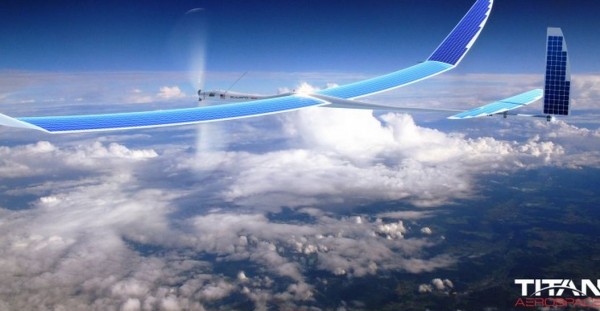Google to Unleash Internet Aerial Drones This Year
| Arthur Dominic Villasanta | | Mar 02, 2015 09:20 PM EST |
(Photo : Google) Google internet drone from Titan Aerospace
Google's first step in bringing the internet to the unconnected takes flight when it launches its first internet aerial drones around the world.
Google senior vice president Sundar Pichai said March 2 at the Mobile World Congress in Barcelona that Google will launch its own aerial drones in the next few months.
Like Us on Facebook
Google's internet drones are made by Titan Aerospace, an American drone maker bought by Google in 2014. Google will use the aerial drones to transmit internet signals to communities that have no Internet access, mostly outside the United States.
Google also calls its unmanned aerial internet drones "solar-powered atmospheric satellites". The Google drones will be the world's first solar-powered atmospheric satellites.
Pichai said drones are much easier to control than Google's soon to be launched internet balloons. The drones and balloons are both efforts covered by Google's Project Loon, a research and development project with the mission of providing internet access to rural and remote areas, specifically the four billion people without internet access.
The high-altitude balloons will be placed in the stratosphere at an altitude of about 32 km to create an aerial wireless network with up to 3G-like speeds.
Pichai said Titan is building super lightweight solar-powered drones that will park in the stratosphere and hover for as long as five years.
Based in Albuquerque, Titan Aerospace develops and manufactures special drones. Google's solar-powered atmospheric satellites resemble large aerial drones. They will be completely powered by the Sun, allowing them to stay in the air for five years with a mission range of over 4 million kilometers.
The solar-powered satellite known as Solara 50 will be launched at night using power from its batteries. During the day, the aircraft will take position 20 km above the Earth, allowing the Sun to charge its solar batteries. The satellite's on-board management system ensures voltage and thermal levels are maintained in the subzero atmosphere.
The Solara 50 has a wingspan of 50 meters and is 15 meters in length. It has a top speed of 104 kilometers an hour.
A single Solara 50 will be able to provide coverage for over 17,800 square kilometers, giving it greater reach than 100 terrestrial cell towers.
Titan Aerospace said the ability to park a stationary payload directly above a specific point is opening dramatic new possibilities and redefining the satellite industry landscape.
"Payloads previously available only on satellites can now be lofted for a fraction of the cost by leveraging the persistent solar UAV platforms."
Another Titan drone, the Solara 60, can reportedly provide "atmospheric parking" for a payload weighing over 100 kg. Titan says this is enough to transform how satellites are taken into space.
©2015 Chinatopix All rights reserved. Do not reproduce without permission
EDITOR'S PICKS
-

Did the Trump administration just announce plans for a trade war with ‘hostile’ China and Russia?
-

US Senate passes Taiwan travel bill slammed by China
-

As Yan Sihong’s family grieves, here are other Chinese students who went missing abroad. Some have never been found
-

Beijing blasts Western critics who ‘smear China’ with the term sharp power
-

China Envoy Seeks to Defuse Tensions With U.S. as a Trade War Brews
-

Singapore's Deputy PM Provides Bitcoin Vote of Confidence Amid China's Blanket Bans
-

China warns investors over risks in overseas virtual currency trading
-

Chinese government most trustworthy: survey
-

Kashima Antlers On Course For Back-To-Back Titles
MOST POPULAR
LATEST NEWS
Zhou Yongkang: China's Former Security Chief Sentenced to Life in Prison

China's former Chief of the Ministry of Public Security, Zhou Yongkang, has been given a life sentence after he was found guilty of abusing his office, bribery and deliberately ... Full Article
TRENDING STORY

China Pork Prices Expected to Stabilize As The Supplies Recover

Elephone P9000 Smartphone is now on Sale on Amazon India

There's a Big Chance Cliffhangers Won't Still Be Resolved When Grey's Anatomy Season 13 Returns

Supreme Court Ruled on Samsung vs Apple Dispute for Patent Infringement

Microsoft Surface Pro 5 Rumors and Release Date: What is the Latest?










